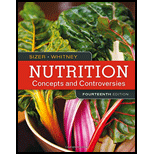
Nutrition: Concepts and Controversies
14th Edition
ISBN: 9781305886865
Author: Sizer, Frances , WHITNEY, Ellie
Publisher: Cengage Learning
expand_more
expand_more
format_list_bulleted
Question
Chapter 1, Problem 5SC
Summary Introduction
Concept Introduction:
The carbohydrates, fats, and proteins are well known as energy-yielding nutrients. They are referred to as macronutrients because they are consumed in the diet in large amounts. Carbohydrates restrain around 4 calories per gram and are generally obtained from whole grains, fruits, vegetables, low-fat dairy products and sweets and processed foods.
Expert Solution & Answer
Trending nowThis is a popular solution!

Chapter 1 Solutions
Nutrition: Concepts and Controversies
Knowledge Booster
Similar questions
- Bile has a role in _________ digestion and absorption. a. carbohydrate c. protein b. fat d. amino acidarrow_forwardWhich of the following statements is not true? a. Essential nutrients can be synthesized by the body. b. Vitamins are required in small quantities for bodily function. c. Some amino acids can be synthesized by the body, while others need to be obtained from diet. d. Vitamins come in two categories: fat-soluble and water-soluble.arrow_forwardAs a person ages, the number of body cells steadily decreases and energy needs decline. If you were planning an older persons diet, what kind(s) of nutrients would you emphasize, and why? Which ones would you recommend an aging person eat less of?arrow_forward
- Some nutritionists claim that the secret to long life is to be slightly underweight as an adult. If a persons weight is related partly to diet, partly to activity level, and partly to genetics, what underlying factors could be at work to generate statistics that support this claim?arrow_forwardAfter you eat too many carbohydrates and proteins, your body converts the excess to storage fats, which accumulate in.____________. a. loose connective tissue b. . dense connective tissue c. adipose tissue d. both b and carrow_forwardLipids are transported from the intestine to the liver by (a) chylomicrons (b) HDLs (c) LDLs (d) glycerol transporters (e) leptinarrow_forward
arrow_back_ios
arrow_forward_ios
Recommended textbooks for you
 Comprehensive Medical Assisting: Administrative a...NursingISBN:9781305964792Author:Wilburta Q. Lindh, Carol D. Tamparo, Barbara M. Dahl, Julie Morris, Cindy CorreaPublisher:Cengage Learning
Comprehensive Medical Assisting: Administrative a...NursingISBN:9781305964792Author:Wilburta Q. Lindh, Carol D. Tamparo, Barbara M. Dahl, Julie Morris, Cindy CorreaPublisher:Cengage Learning



Comprehensive Medical Assisting: Administrative a...
Nursing
ISBN:9781305964792
Author:Wilburta Q. Lindh, Carol D. Tamparo, Barbara M. Dahl, Julie Morris, Cindy Correa
Publisher:Cengage Learning


